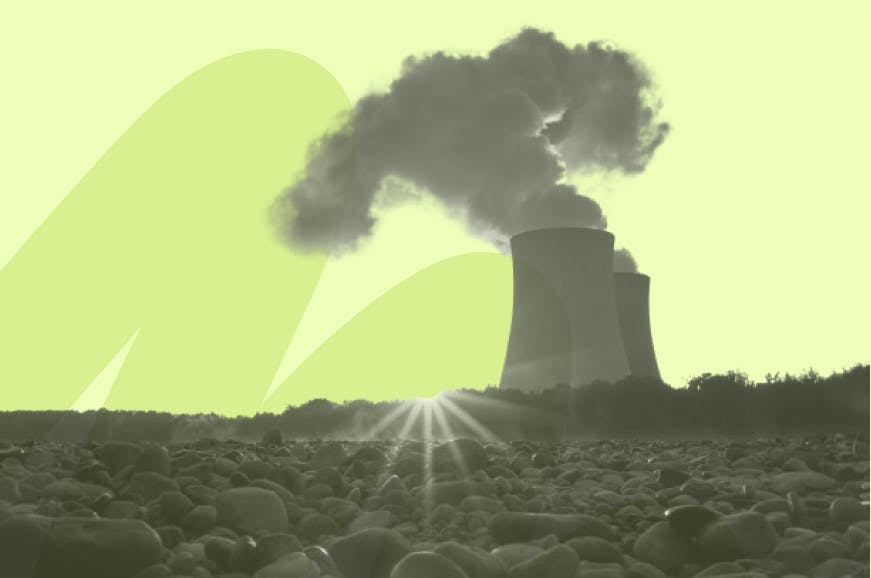
What are the 3 Pillars of Corporate Sustainability?
In this article, we'll explore what the 3 pillars of corporate responsibility are, why they're important, and how businesses can turn them into practical action.
ESG / CSR
Industries



When we think of air pollution in a powerhouse country like the U.S., it’s easy to assimilate air pollution with climate change and global warming – and for it to mean nothing more besides its contribution to rising global surface temperatures. However, air pollution does more than just impact the environment and the health of the planet – but air pollution can be detrimental to U.S. citizens.
👉 Where does the U.S. stand in terms of air pollution? Is it possible to reduce air pollution in the U.S., or must the country deal with the consequences of their actions that have created such high levels of air pollution in the first place?
In this article, we'll explain what air pollution is, the negative effects, and how the U.S. and the world can work to mitigate air pollutants.
In fact, air pollution has negatively impacted the globe to the extent that nearly 7 million people die annually as a result of the harmful toxins emitted with air pollution.
💡 The majority of air pollution comes from extensive energy use and mass production – but air pollution is also the result of high carbon emitting activities, such as air travel or components of the tech industry such as data storage.
While the U.S. has tried to rectify the negative impacts of air pollution, the truth is air pollution continues to threaten both people and the planet – as exposure to air pollution from nearby power plants can compromise outdoor air pollution, hindering outdoor gatherings.
💡 In addition to this, poor air quality as a result of increased use of fossil fuels or volatile organic compounds could in turn resort people to ramp up the use of air conditioners – which doesn't get to the bottom of the root cause of pollutants emitted.
Furthermore, increased levels of fine particulate matter such as sulfur dioxide, nitrogen dioxide, carbon monoxide, carbon dioxide, and even from natural gas can provoke indoor air pollution and make daily activities such as school and work dangerous for our health.
The table below will depict the impacts of different kinds of air pollution emissions, specific hazardous air pollutants, and various fine particles:
| Pollutant | Impacts | Sources |
|---|---|---|
| Carbon Dioxide (CO2) |
- Contributes to global warming - Leads to ocean acidification when absorbed by seawater |
- Fossil fuel combustion - Deforestation - Industrial processes |
| Sulfur Dioxide (SO2) |
- Causes acid rain, damaging ecosystems - Harms respiratory health - Reduces visibility, leading to haze |
- Coal and oil combustion in power plants - Industrial facilities - Natural sources like volcanic eruptions |
| Nitrogen Oxides (NOx) |
- Forms ground-level ozone, contributing to smog - Causes acid rain - Harms respiratory health |
- Vehicle emissions - Power plants - Agricultural activities |
| Carbon Monoxide (CO) |
- Reduces oxygen delivery to the body, causing health issues - Contributes to the formation of ground-level ozone |
- Incomplete combustion of fossil fuels - Vehicle emissions - Indoor sources like gas heaters |
| Particulate Matter (PM2.5 and PM10) |
- Penetrates deep into lungs, causing health issues - Contributes to haze and reduced visibility |
- Construction activities - Industrial processes - Vehicle emissions |
| Ozone (O3) |
- Causes respiratory issues - Damages crops and ecosystems - Contributes to smog |
- Reaction of NOx and volatile organic compounds (VOCs) in sunlight |
| Lead (Pb) |
- Harms neurological development, particularly in children - Damages organs and systems over long-term exposure |
- Industrial processes - Leaded gasoline (historically) - Batteries and paints |
| Volatile Organic Compounds (VOCs) |
- Contribute to smog formation - Harm respiratory and cardiovascular health - Some are carcinogenic |
- Paints and solvents - Industrial processes - Vehicle emissions |

Air pollution affects the planet by encouraging ozone depleting substances to infiltrate the atmosphere and intoxicate the surrounding areas. Clearly, air pollution can continue to negatively affect climate change – and prevent nations like the U.S., which really need to get started in drastically reducing their emissions, from doing so successfully.
💡 However, air pollution doesn’t just impact the planet – but even more concerning, air pollution exposure can cause death in American citizens living in areas with high levels of air pollution.
The extent to which air pollution impacts the human species depends on the type of air pollution the person is exposed to and how often they are exposed to that type of air pollution. However, the problem in the U.S. is that air pollution is becoming more prevalent – with high levels of soil, dust, allergens, and gasoline becoming the new norm. This has made Americans more susceptible to the negative effects of air pollution than ever before.
Air pollution can have an effect on a wide variety of pre-existing conditions, such as asthma or people who already suffer from seasonal allergies.
👉 In fact, a 2020 report from Harvard revealed that COVID-19 related casualties were higher in areas with high levels of air pollution – demonstrating just how aggravating and taxing air pollution can be on the human body.
Has the United States attempted to improve air quality in the nation?

It’s no secret that air pollution in the U.S. continues to skyrocket to unprecedented levels – with the United States being the second largest greenhouse gas emitter in the world. However, that doesn’t mean that the U.S. hasn’t tried to course correct since the drastic increase in emissions following the Industrial Revolution.
Previously, the U.S. established the Clean Air Act, also known as the CAA for short – which is a federal law that helps to regulate how many emissions can be created from different sources. The Clean Air act allowed the Environmental Protection Agency, also known as the EPA, to pass air quality standards for the U.S. – otherwise known as the National Ambient Air Quality Standards, or NAAQS.
These air quality guidelines were set with the intention of protecting the future health of Americans, public welfare, and to regulate the amount of greenhouse gas emissions and ozone depleting substances that could be emitted to the air.
The main goals of setting air pollution levels under regulations such as the Clean Air Act include:
When the U.S. passed the Clean Air Act, the overarching goal was to improve the nation’s air quality, reduce emissions, and raise awareness on the values depicted in the National Ambient Air Quality Standards.
💡 As a result, the Clean Air Act was successful – as it helped to prevent nearly 230,000 air pollution related deaths and reduced the amount of common air pollutants like carbon monoxide by 74%, and lead by 82%.
In turn, this improvement in the nation’s air pollution helped to stimulate biodiversity and ultimately aid in the fight against climate change.
Tactics like the Clean Air Act have helped the U.S. to take control over air pollution in the past – but air pollution still remains as a threat to American citizens today, despite all of the progress made with previous air pollution legislation.

According to the American Lung Association in April 2021, it was estimated that over 135 million Americans were living with air pollution, which subjects them to continuous health hazards and puts their lives in danger.
💡 Air pollution is still one of the most prevalent environmental problems in the U.S., despite the positive progress made by acts such as the Clean Air Act – as industrial processes and burning fossil fuels continue to ramp up in the United States, and are bound to increase under Trump's return to the White House.
However, it is worth noting that even with the beneficial impact made by the Clean Air Act – the health of over a third of Americans has continued to be threatened by air pollution since 2013. That’s over a decade of no progress in rectifying the air pollution predicament in the United States.
👉 The problem is that there are two types of air pollution that the Environmental Protection Agency and the general U.S. government tend to focus on: air pollution related to particulate matter, and air pollution relation to the ground-level ozone.
Particle matter is a type of air pollution that occurs when small pieces of liquids and solids linger in the air: such as remnants from dust, dirt, or smoke. It is estimated that around 21 million Americans live in regions of the U.S. with this type of air pollution, and while it is noticeable to the naked eye – this type of air pollution can often be seen at sunset alongside an evening haze.
On the other hand, air pollution from ground-level ozone pollutants refers to smog – which is the type of air pollution that comes from gasoline powered cars and nuclear power plants. This remains as the more threatening type of air pollution in the U.S., as over a third of Americans live in areas with high levels of ground-level ozone air pollution.
However, the good thing is that this is the kind of air pollution that the U.S. can easily take control of and implement action plans to reduce.

Air pollution is a big problem in the United States, but the nation doesn’t have to sit back and watch it destroy the lives or the planet – there are several things that the government can do to mitigate excessive air pollution.
💡 In addition to the Clean Air Act and continuing to amend it in accordance with today's levels of air pollution, the U.S. could encourage citizens to cut back on their own production of greenhouse gas emissions – which is the type of air pollution that remains most threatening for Americans.
To cut back on these ground level ozone sources of air pollution, Americans would have to make some serious changes – many of which most U.S. citizens view as costly and won’t dedicate themselves to changing. For instance, switching to the use of an electric car or even a hybrid vehicle could reduce up to a quarter of emissions per household. However, the problem remains that hybrid and electric cars are more expensive than gasoline powered cars – making Americans hesitant to buy them.
This is why the U.S. government should, can, and already has stepped in – with legislation to provide Americans with the incentive necessary to help reduce their negative contributions to air pollution. This has already been implemented with the Inflation Reduction Act of 2022, where Americans are now subject to a tax reduction for purchasing electric vehicles and even installing solar panels into their homes.

As climate change continues to threaten U.S. citizens heading into 2025, the country is getting tighter on the regulations necessary to combat the negative effects of air pollution.
The biggest contributors to excessive greenhouse gasses in the United States remain to be transportation, industrial production, and electricity usage. In order to combat these major contributors, the United States Environmental Protection Agency recently announced their proposal to update the national air quality standards after a decade of no reform.
If the EPA is able to rectify the current federal air quality standards, the limit of the amount of micrograms of particulate matter allowed to be emitted into the atmosphere could be reduced to single digits – which could greatly reduce overall air pollution in the country.
Air pollution is a lot like leaving a pile of dirty dishes in the sink. Those dishes have no reason for sitting in the sink as they are, and they are the fault of no one else except those who live in the household. The people living in the household are left with two choices: watch the dirty dishes pile up, or take the time to start cleaning them and see the spotless again.
If reading this article about air pollution in the U.S. has made you interested in reducing your carbon emissions to further fight against climate change – Greenly can help you!
At Greenly, we understand that trying to break down complex topics such as fine particle pollution and how they may impact your business can be challenging – but we're here to teach all you need to know and more to ensure that harmful emissions doesn't get in the way of your company's success.
Greenly can help you make an environmental change for the better, starting with a carbon footprint assessment to know how much carbon emissions your company produces – request a free demo here.
